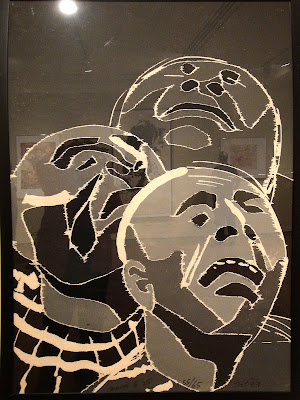He's Monkey - woodblock key - image size 11 x 17"
I had to put this woodcut on hold for a bit over a month while other studio projects with deadlines took precedent. But this image which accompanies the exquisite corpse blog I contribute to finally got some attention this past week.
Analogue Narratives is currently an online project in search of a physical exhibition space. It began three years ago as a collaborative writing project based on the premise of finishing Rene Daumal's unfinished novel, Mount Analogue. Daumal passed away leaving his surreal tale of the search for enlightenment without an ending. Our story picks up on the fabled mountain of no certain location and the artists I work with contribute writings, illustrations and video concerning our own search for an ending.
Stack of 5 clear acetates with a ghost of ink remaining after transfer to the plywood blocks.
I depart from the traditional methods of transferring image to the blocks. After I work out my colors and the number of blocks I need to get those colors, I print each color as black on acetate and place them on the blocks while the ink is sill wet.
The image at the top now carved - (black ink from proofing)
Block for deeper violets and lemon yellow on monkey.
Block for ochre in sail area
Block for background gradients
Carved area allows white of paper to form the snow pack on the mountain.
Block for orange/reds (almost finished)
This image began as a combination of several ink drawings that I scanned into Photoshop, combined, experimented with coloration and later separated the colors for the blocks. This forms a starting point as I begin to work with various inks this coming week.
Admiral He's Monkey © William Evertson 2013



























